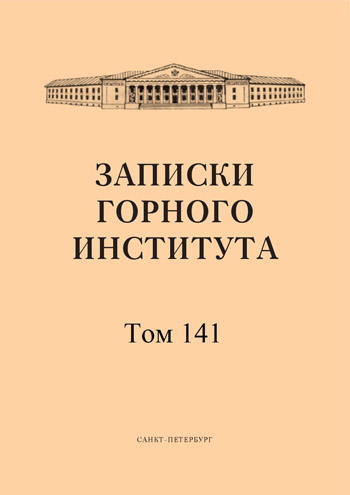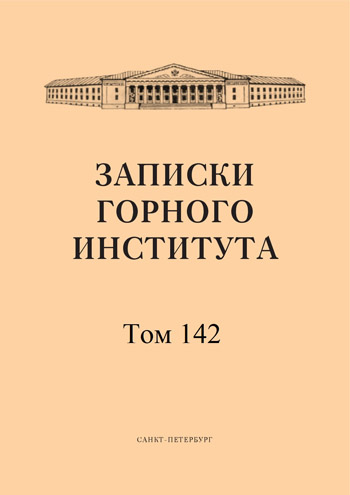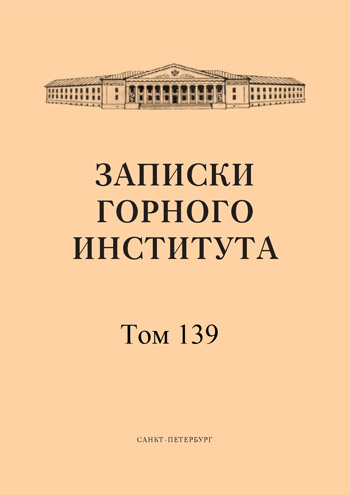-
Date submitted1994-08-28
-
Date accepted1994-10-14
-
Date published1995-02-01
Reliability assessment of a multi-drive belt conveyor
- Authors:
- K. A. Vasiliev
- I. I. Margolin
A multi-drive belt conveyor (MNLC) when analyzing its reliability can be considered as an object consisting of two structural elements: the drive system and the complex of all other parts of the conveyo
-
Date submitted1994-08-07
-
Date accepted1994-10-10
-
Date published1995-02-01
New designs of intermediate drives for belt conveyors
- Authors:
- Yu. D. Tarasov
- D. A. Jungmeister
The developed designs of intermediate drives with increased specific traction capacity (ratio of traction force developed by the drive to its length) are characterized by a curvilinear profile of the contact zone between the endless drive and conveyor belts. This allows the tractive force transmitted to the conveyor belt to be implemented not only due to the weight of the conveyor belt itself and the load on it (as in known designs of linear drives), but also due to the tension of the conveyor belt itself, enveloping the convex curvilinear profile of the working branch of the drive belt at the appropriate angle of girth. And the girth angle, and thus the value of the tractive force transmitted to the conveyor belt, can be automatically adjusted depending on the load on the conveyor belt from the weight of the cargo transported by it by changing the curvature of the profile of the working branch of the drive belt. The girth angle can be increased by combining convex and concave sections of the conveyor belt.
-
Date submitted1994-08-13
-
Date accepted1994-10-07
-
Date published1995-02-01
Vacuum belt conveyor drives with nozzle air suction
- Authors:
- K. A. Vasiliev
In the proposed designs of vacuum drives of belt conveyors, having increased frictional traction ability, the actuator is a drum or a traction belt. Obligatory design elements of these actuators are chambers of reduced air pressure, permanently communicated during operation of vacuum actuators with grooves-channels in the working surface of drums or traction belts, which are in frictional interaction with the load-carrying belt of the conveyor. The presence of such chambers complicates the design of vacuum drives.
-
Date submitted1994-08-11
-
Date accepted1994-10-05
-
Date published1995-02-01
Loading of high-speed belt conveyors
- Authors:
- Yu. D. Tarasov
Loading of high-speed main belt conveyors at conveyor belt velocities vl > 5 m/s is inexpedient to carry out with the help of traditional feeding devices, as well as chutes-accelerators, as the final velocities vk of cargo flow when using these technical means will always be less vl than the belt velocity of the main conveyor. Provision of the condition vc = vl is practically impossible for two reasons: it is necessary to have a large length of the inclined chute; the speed of cargo movement at speeds, even significantly lower than vl stabilizes due to the sailing of the cargo.
-
Date submitted1994-08-15
-
Date accepted1994-10-02
-
Date published1995-02-01
Peculiarities of traction calculation of mine automated electric locomotive transport
- Authors:
- V. N. Kordakov
Improvement of mine electric locomotive drive aimed at creation and implementation of automatic starting systems determines the definition of adjustable drive parameters at the design stage. At given parameters of the automated drive, carriages, grip coefficient of electric locomotive wheels with rails, it is reasonable to calculate the train mass under the condition of its acceleration. The mass can be limiting in comparison with the mass determined by other known conditions of traction calculation.
-
Date submitted1994-08-14
-
Date accepted1994-10-25
-
Date published1995-02-01
Mine transportation system driven by linear induction motors
- Authors:
- A. F. Borozenets
The created system of mine transportation driven by linear asynchronous motors (LAD) includes LAD-driven mining transport machines (MTM) with C-section rotor and inductor without frontal parts, traction substation, devices for loading, unloading of rock mass, devices for automatic stopping in case of power failure, devices for moving mine cars, devices for detecting and removing ferromagnetic objects from the flow of the transported cargo, equipped with control systems; devices for dispatching and removing ferromagnetic objects from the flow of the transported cargo; dispatch communication devices of the STMs with the LADs also include rail, monorail and conveyor transportation devices.
-
Date submitted1994-08-23
-
Date accepted1994-10-27
-
Date published1995-02-01
Calculation of hydrotransport systems using computers
- Authors:
- V. I. Alexandrov
- V. P. Dokukin
- A. A. Kuleshov
In the process of designing of hydraulic conveying systems it is necessary to perform a large volume of calculations due to the necessity to analyze different variants of scheme layout, to determine the parameters of mixture flow, economic indicators, etc. This volume of work can be performed rather quickly with the help of a computer program. This amount of work can be performed rather quickly with the help of a computer program. However, it requires the development of a number of programs, of which a package of programs should be formed to solve various problems in the design, operation and reconstruction of hydrotransport complexes.
-
Date submitted1994-08-11
-
Date accepted1994-10-01
-
Date published1995-02-01
Piping system for transportation of solid materials
- Authors:
- A. B. Nezametdinov
Pipeline transportation in normal operation has advantages over other modes of transportation in that it is less polluting to air, water and land. When a pipeline bursts as a result of a hydrostroke, increased wear and tear of pipe sections or sudden changes in ambient air temperature, these advantages are lost.
-
Date submitted1994-08-18
-
Date accepted1994-10-11
-
Date published1995-02-01
Flow model of soft serpentinite ore hydraulic mixture
The existing reserves of oxidized nickel ores in the Republic of Cuba consist of limonite (ferruginous) and serpentinite (magnesian) fractions, with serpentinite accounting for approximately one third of the reserves. The technological process of processing serpentinite ores at the Pedro Soto Alba plant and the difference in geodetic altitude between the plant and the deposit make it more advantageous to use gravity hydraulic transport of the enriched mineral to the metallurgical plant as the most environmentally friendly type of transportation of enrichment products and, moreover, does not require energy supply. However, the composition of the solid phase of the pulp creates certain difficulties for its movement.
-
Date submitted1994-08-24
-
Date accepted1994-10-24
-
Date published1995-02-01
Experimental study of dynamic coefficients of hydro-monitor jets
- Authors:
- K. G. Asatur
- B. S. Makhovikov
- I. I. Doroshenko
The beginning, laid in the USSR in 1953, of hydraulic stripping of coals and strong rocks in the mining industry, led to a number of domestic and foreign experimental studies of nozzles in order to determine those of their profiles, which provide maximum forces on the bottom hole - preventing the flow.
-
Date submitted1994-08-05
-
Date accepted1994-10-27
-
Date published1995-02-01
Theoretical analysis of the sedimentation process in thickeners with inclined plates
- Authors:
- V. I. Alexandrov
- R. F. Nagaev
Various types of thickeners of initial two-phase mixture are used in technological processes of hydraulic transportation of bulk materials. In recent years, especially abroad, thickeners of plate type, so-called Lamell have become widespread. The principal difference of these thickeners from the traditional ones, for example type Dora, is the division of the initial flow of thickened hydraulic mixture into a number of laminar flows by means of thin plates, installed obliquely in the body of the thickener, at some small, usually 30-50 mm, distance from each other.
-
Date submitted1994-08-16
-
Date accepted1994-10-03
-
Date published1995-02-01
Environmental aspects of large-size tire operation at open-pit mines
- Authors:
- V. Yu. Koptev
- A. A. Kuleshov
Annually at 18 plants of CIS countries 70 million tires are manufactured, for the production of which 15 % of the total gross output of petrochemical and oil refining industry is used. The number of truck tires is 52.5 million - 75 % of all tires (in the USA - 20 %, in Western European countries - up to 12 %). The share of large-size tires (LSTs), which are equipped with dump trucks, construction and agricultural machines, reaches 2 % (in the USA - 1 %). LSTs have high material and energy intensity, which determines their high cost. Mining operations cause great damage to the environment, and a comprehensive environmental assessment of them has not yet been given. Since quarry vehicles are one of the main sources of pollution, the paper attempts to assess the environmental impact of LSTs on the environment during their operation at Russian quarries and utilization.
-
Date submitted1994-08-01
-
Date accepted1994-10-24
-
Date published1995-02-01
Ways to improve the efficiency of heavy-duty dump trucks in the conditions of coal mines in Vietnam
- Authors:
- A. A. Kuleshov
- Phan Xuan Binh
There are coal deposits in all provinces of Vietnam, but the most significant ones are located in the mountainous areas of Northern Vietnam. The productivity of the nine mines in operation ranges from 100 to 1,500,000 tons/year, the most common being 700 to 1,000,000 tons/year.
-
Date submitted1994-08-19
-
Date accepted1994-10-19
-
Date published1995-02-01
Efficiency of mine dump trucks with electric and mechanical drives for the conditions of the Udachny quarry
- Authors:
- I. V. Zyryanov
- V. M. Bogatyrev
- E. A. Potapova
The trend prevailing in recent decades in the development of quarry road transport is to increase the load capacity of machines and their reliability in order to reduce the cost of transportation. However, as machine parameters increase, limitations on certain components arise. In recent years, the machines with load capacity of 216 tons with electric drive have appeared. Due to the application of original technical solutions, more advanced alloys, new designs of bearings, braking systems and electronic devices, a family of heavy-duty dump trucks with mechanical drive with a maximum payload capacity of 217 tons has been created.
-
Date submitted1994-08-29
-
Date accepted1994-10-24
-
Date published1995-02-01
Results of industrial tests of anti-smoke additives to diesel fuel in conditions of the Tsentralny mine of PO Apatit
- Authors:
- A. A. Kuleshov
- O. D. Serebrennikov
- V. A. Fomin
Currently, hundreds of millions of internal combustion engines are in operation in the world. According to various data, they burn more than 1 billion tons of oxygen per year, emit into the atmosphere 120-150 million tons of carbon monoxide, more than 1 million tons of sulfur oxide, tens of millions of tons of unburned hydrocarbons and nitrogen oxides. The situation is particularly difficult at open-pit mining operations, where a large number of dump trucks with a carrying capacity of 30-180 tons, bulldozers and other equipment are concentrated in a relatively small space. Synergetic interaction of individual components of harmful emissions and dust particles forming photochemical smog cause changes in physiological processes in the human body. In addition, in some periods at the quarries due to severe atmospheric pollution completely or partially stops work, waiting for ventilation idles expensive mining and transportation equipment.
-
Date submitted1994-08-28
-
Date accepted1994-10-01
-
Date published1995-02-01
Improving the operational reliability of vehicles by improving current repairs, with the application of unit repairs
- Authors:
- R. S. Lukinskiy
- I. G. Saprykin
- V. N. Popov
Improving the operational reliability of automobiles is an important and multifaceted task. When considering this problem, the comparison of domestic car brands with foreign analogs on a number of indicators is of special interest.
-
Date submitted1994-08-24
-
Date accepted1994-10-24
-
Date published1995-02-01
Reliability issues of pneumatic brake actuators of vehicles
- Authors:
- N. I. Verevkin
- E. D. Stern
The issues of reliability of pneumatic brake drives of vehicles nowadays become more and more important in the light of increasing requirements to braking systems in terms of decreasing the time of braking mechanisms operation, decreasing the braking distance of vehicles, increasing the maximum deceleration created by the braking system as a whole. In this case there is a very difficult task of finding reserves of braking systems, because at first glance it seems that the pneumatic braking system has already reached the limit of its development and can not be further improved, except for the use of microprocessor technology and an on-board computers, which, along with many positive properties, significantly increases the cost and complexity of the system itself, and ultimately reduces its maintainability and, as a consequence, reliability .
-
Date submitted1994-08-04
-
Date accepted1994-10-26
-
Date published1995-02-01
Research of dynamics of movement of dump dump trucks BelAZ-7519
- Authors:
- N. V. Zyryanov
Extra heavy-duty dump trucks are operated under severe conditions and usually do not reach the manufacturer's specified service life (at the design 450 thousand km the actual mileage is 150-250 thousand km). Basic designs of dump trucks operate in modes of multi-cycle alternating dynamic loads during excavator loading and when driving on quarry roads. These loads determine the reliability and durability of assemblies and systems of the dump truck
-
Date submitted1994-08-08
-
Date accepted1994-10-28
-
Date published1995-02-01
Methodology for predicting tire life of dump trucks
- Authors:
- V. Yu. Koptev
It is known that the life of machines and their assemblies depends on the strength of parts and loading modes. To determine the time of their failure, statistical processing of observations in specific operating conditions is performed, but it is difficult to obtain analytical dependencies of the resource on various factors in this case. When applying new materials or changing the design of the part, it is not possible to complete operational information about the impact of changes made by designers on the resource and justify the necessary technical solutions to improve reliability. A similar situation occurs when designing tires of dump trucks.
-
Date submitted1994-08-28
-
Date accepted1994-10-02
-
Date published1995-02-01
Calculation and selection of unit parameters for production of flammable fuel briquettes
- Authors:
- Yu. D. Tarasov
For production of flammable (ignitable from a match) coal fuel briquettes a unit consisting of kinematically and functionally connected extruder, cutting machine and drying conveyor with automatic regulation of parameters depending on the speed of extrusion of raw fuel element from the extruder is developed.
-
Date submitted1994-08-24
-
Date accepted1994-10-13
-
Date published1995-02-01
Analysis of methodological errors of the dynamic thermovacuum method of measuring moisture content of bulk materials
- Authors:
- V. I. Malarev
- R. M. Proskuryakov
Based on the analysis of thermal processes in the system of sample - cuvette - medium a mathematical model of heat and mass transfer of the thermovacuum method of measuring moisture.
-
Date submitted1994-08-07
-
Date accepted1994-10-01
-
Date published1995-02-01
Instrument for measuring the thermal conductivity of rocks
- Authors:
- V. I. Malarev
The device allows to measure thermal conductivity of various dispersed materials, including moistened ones. The measurement is performed by the stationary comparative plate method.
-
Date submitted1994-08-23
-
Date accepted1994-10-29
-
Date published1995-02-01
Akvaterm dynamic thermovacuum moisture meter
- Authors:
- V. I. Malarev
- R. M. Proskuryakov
The high metrological capabilities of thermovacuum control of bulk material moisture content are largely offset by a number of fundamental disadvantages inherent in this direction of moisture measurement.
-
Date submitted1994-08-24
-
Date accepted1994-10-12
-
Date published1995-02-01
Dust control in medium crushing sections at potash mines in the Pre-Carpathian region
- Authors:
- M. M. Smetanin
- I. P. Ozernoi
Currently, the main means of dust control in the departments of medium crushing are sheltering dusty equipment and separate units of mechanisms and devices; aspiration of dusty air from under the shelters of vibrodionic screens, hammer crushers and ore transfer units on conveyors with subsequent purification of air from dust in dust-collecting installations such as SIOT; moistening of ore on feeders and dust removal.
-
Date submitted1994-08-20
-
Date accepted1994-10-01
-
Date published1995-02-01
Approximate formulas for calculating the parameters of stationary air movement in the main air pipeline
- Authors:
- K. A. Dolgov
The following system of differential equations was proposed to calculate the parameters of steady-state air flow through a sealed horizontal air duct.
-
Date submitted1994-08-26
-
Date accepted1994-10-30
-
Date published1995-02-01
Technological scheme of the complex for overburden transportation and hydrodumping
- Authors:
- P. G. Isaev
One of the effective ways of overburden transportation at open pits is hydraulic transportation. Application of this method in the period of quarry operation is sometimes difficult due to the presence in the quarry of other technological schemes with the use of dry mining equipment or complicated mining and technical conditions. At the same time, when using only dry mining equipment, it is not always possible to solve the whole complex of problems associated with excavation, transportation and stacking of rocks in dumps at a high technical and economic level.
-
Date submitted1994-08-08
-
Date accepted1994-10-27
-
Date published1995-02-01
Dynamics of shockless mode of vibrating jaw crusher
- Authors:
- M. N. Arkhipov
- R. F. Nagaev
- V. Ya. Turkin
A symmetrical crusher with two self-synchronizing vibration exciters is considered.


